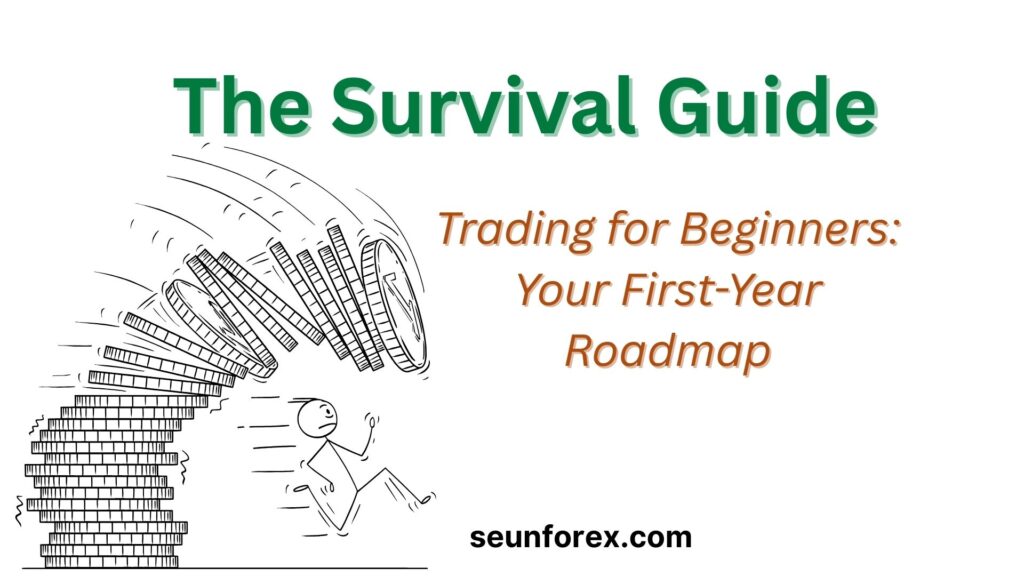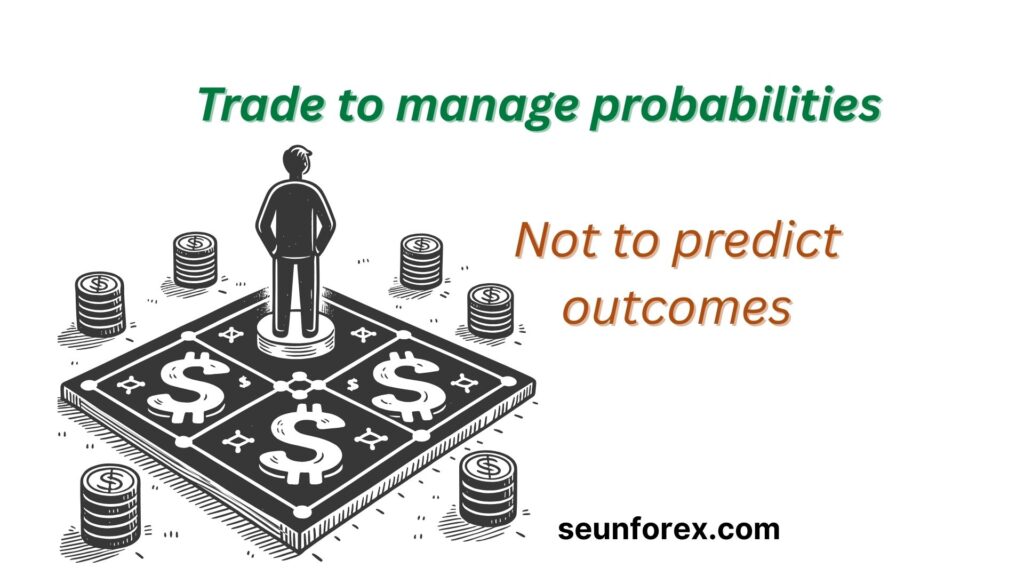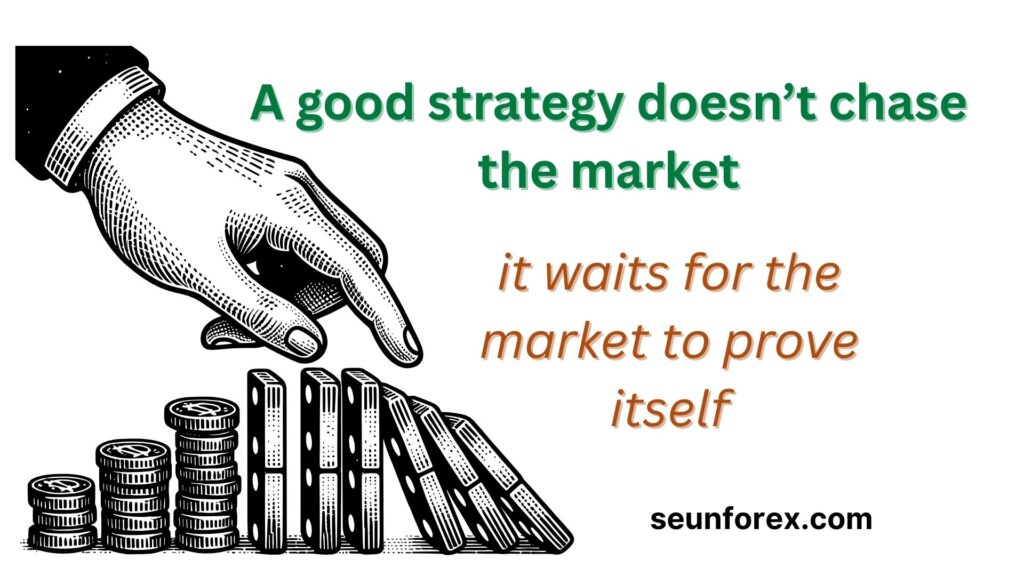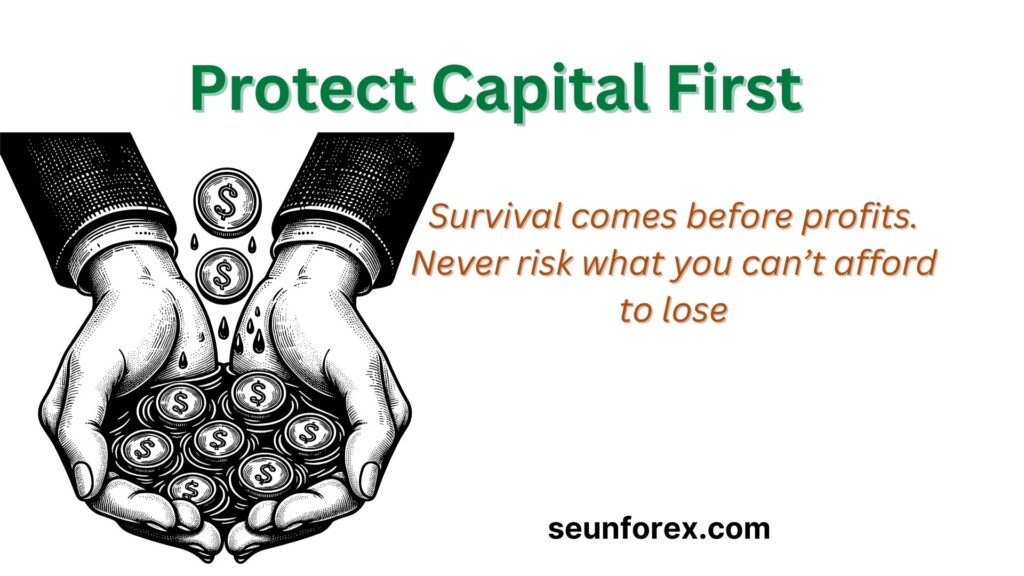
🎬 Introduction: Welcome to the Battlefield
Trading for beginners isn’t about quick wins — it’s about survival. Most traders don’t fail because they lack intelligence. They fail because they step into the market with the wrong expectations.
Imagine walking into a battlefield blindfolded, sword raised, full of ego, and calling it “strategy.” That’s how most beginners approach their first year of trading.
The brutal truth?
Markets don’t reward intelligence. They reward discipline, patience, and risk management.
If you’re reading this, chances are you’re starting your trading journey — and you’ve heard the statistics: 80–90% of traders lose money in their first year. Scary? Yes. Avoidable? Absolutely.
This guide isn’t about magic indicators or the latest “holy grail” system. It’s about survival. Because if you can survive your first year in trading, you give yourself a real chance to thrive in the years ahead.
And survival comes down to one thing: mindset.
Let’s break down the shifts every trading beginner must make if they want to move from frustrated amateur to focused trader.
🧠 Active vs. Reactive Thinking
We’re taught in school and at work to “take initiative” and “make things happen.” Sounds like good advice, right?
Not in trading.
In the market, the best traders are reactive, not impulsive. They don’t impose their will on the market. They wait, they watch, and they only act when the odds are in their favor.
As Mark Minervini famously said:
“The market doesn’t pay you to be active. It pays you to be patient.”
For trading beginners, this is hard. You want action. You want to feel like you’re progressing. But in trading, sometimes the most profitable thing you can do is nothing.
✅ Survival Tip for trading for beginners: Add “do nothing” to your list of valid trading decisions.
🧍♂️ My Logic vs. Crowd Logic
Markets are not a debate. They’re an auction.
You can do the cleanest technical analysis in the world — your Fibonacci levels, your support and resistance zones, your perfect trendline. But guess what? The market doesn’t care.
What moves price is crowd psychology, not your individual logic.
That’s why meme stocks can skyrocket while “quality” companies stagnate. It’s not rational. It’s emotional.
Professional traders don’t try to be “right.” They try to be aligned.
✅ Survival Tip: Don’t ask, “Am I right?” Ask, “Am I aligned with what the market is doing?”
🔭 Assumption vs. Speculation
Most trading beginners blow up because they try to predict instead of speculate.
Prediction is ego.
Speculation is observation.
Tom Basso explained it best:
“I stand on a hill and watch two armies battle. When one starts to win, I join them.”
That’s trading in one sentence.
For trading for beginners, the lesson is simple: don’t predict the future. Wait until the market shows its hand — then join the side with momentum.
✅ Survival Tip for beginners: Define what the market must prove before you enter a trade.
🥊 Ego vs. Humility
In school, you’re rewarded for being right. In trading, you’re punished for trying to always be right.
The best traders? They’re humble.
- They don’t marry trades.
- They don’t hold losers to prove a point.
- They don’t sulk when they’re wrong.
When a setup breaks down, they cut the trade. No hesitation.
As Ed Seykota warned:
“If you’re not willing to take a small loss, sooner or later you’ll take the mother of all losses.”
✅ Survival Tip: Losing is not failure. Refusing to cut a loser is.
🎯 Risk vs. Calculated Risk

Here’s a mindset that separates pros from trading beginners:
Beginners ask: “How much can I make?”
Pros ask: “How much can I lose?”
Every trade is a bet. You’re not a prophet — you’re a probability manager.
Think of it this way:
- 7 losing trades = –$1 each = –$7
- 3 winning trades = +$5 each = +$15
- Net result = +$8
That’s not luck. That’s math working in your favor.
For trading for beginners, this is the essence of risk management — focus on protecting capital first, and profits take care of themselves.
✅ Survival Tip: Structure your trades so your average win is bigger than your average loss.win is bigger than your average loss.
🧮 Goals vs. Probabilities
Retail traders love setting income targets:
“$500 a day.”
“10% this month.”
But the market doesn’t care about your targets.
Professional traders focus on probabilities, not arbitrary goals. They know they can’t control outcomes — only the quality of their bets.
As Marty Schwartz said:
“You don’t trade because you’re bored. You trade because conditions demand it.”
For trading for beginners, this is a critical mindset shift. Success in your first year of trading comes from making consistent, high-probability bets — not chasing daily or monthly income targets.
✅ Survival Tip: Drop the income targets. Focus on making good bets when the odds are in your favor.when the odds are in your favor.
🥶 Emotion vs. Execution

Hope is not a strategy. Neither is anger.
Most beginners blow accounts because they trade based on feelings:
- They hold losers out of hope.
- They double down out of anger.
- They exit winners too fast out of fear.
Professionals don’t let emotions run their trades. They let rules run their trades.
✅ Survival Tip: Write your rules down. Follow them without exception.
💰 One Big Hit vs. Many Small Edges
Beginners dream of catching “the big one.” Buying the bottom, selling the top.
But here’s the reality: pros don’t care about bottoms or tops. They care about stacking small, consistent edges.
Big wins come from a series of disciplined trades, not one lucky YOLO.
✅ Survival Tip: Don’t swing for home runs. Aim for base hits that add up.
📉 School Logic vs. Market Logic
In school: A + B = C.
In trading: A + B might equal C, Z, or an explosion.
The market is probabilistic, not certain. If you need guarantees, trading will break you.
✅ Survival Tip: Accept uncertainty. Focus on edge, not certainty.
✅ Pro Trader Mindset Checklist
Before you risk real money, ask yourself:
🔲 Am I reacting to what the market gives me, or imposing what I want?
🔲 Do I accept small losses quickly and without ego?
🔲 Do I think in probabilities, not certainties?
🔲 Am I emotionally neutral, win or lose?
🔲 Do I follow a repeatable system with discipline?
🔲 Do I have the patience to wait for great setups?
If you answered “no” to more than one of these, the market will be your teacher — and her tuition is paid in losses.
🪞 Trading Is a Mirror
The market isn’t your enemy. It’s your mirror.
It reflects your discipline, your impulses, and your beliefs about money. That’s why true trading mastery isn’t about finding the perfect strategy.
It’s about mastering yourself.
As Van K. Tharp put it:
“In the long run, you don’t trade the market. You trade your beliefs about the market.”
Cold blood. Clear rules. An unshakable mindset is what separates trading beginners from seasoned pros.
2: Risk Management, Strategies, and Trade Execution
Most beginners jump straight into strategy. They think trading is about finding the right indicator or the secret chart pattern. But here’s the reality:
Without risk management, even the best strategy will destroy you.
With risk management, even an average strategy can keep you alive long enough to get good.
Let’s break it down.
🛡️ Risk Management: Your Survival Shield
Risk management is the difference between a one-year trader and a ten-year trader.
Most beginners ignore it because it feels boring. But the truth? Risk management is trading.
Here are the non-negotiables:
1. Never Risk More Than 1–2% Per Trade
If you have a $1,000 account, risking $100 per trade is financial suicide. One bad week and you’re done.
Instead, keep your risk at 1–2% per trade. That way, even a losing streak won’t wipe you out.
📌 Example:
- Account = $1,000
- Risk = 1% = $10 per trade
- Stop-loss = 50 pips
- Position size = 0.02 lots (approx)
That’s survival math.
2. Always Use a Stop-Loss
A stop-loss isn’t a sign of weakness. It’s insurance.
Professional traders never enter a trade without defining the exit. They decide in advance:
👉 “If price reaches here, I’m wrong. I’ll take the loss and move on.”
For trading beginners, this is one of the hardest lessons in risk management for beginners. A stop-loss isn’t optional — it’s survival.
Beginners who avoid stop-losses pray, hope, and wait for a bounce. That’s why most blow up in their first year of trading.
✅ Survival Tip: Always place a stop-loss before entering. Treat it as insurance, not weakness.
3. Aim for Positive Risk-to-Reward
If you risk $1, aim to make $3–$5.
That way, even with a 30–40% win rate, you can still be profitable.
📌 Example:
- 10 trades
- 6 losses = –$60
- 4 wins = +$80 (2R each)
- Net = +$20
It’s not about winning often. It’s about winning big when you win.
4. Respect the Daily/Weekly Loss Limit
Every pro trader for beginners knows when to stop trading for the day or week.
Why? Because losses mess with your head. After two or three losing trades, your decision-making becomes emotional.
✅ Rule: Max 2%–3% loss per day. When hit, close the laptop.
⚔️ Strategies That Actually Work for Beginners

Here’s the good news: you don’t need a “holy grail” or complicated indicators. As a trader for beginners, you just need a simple, repeatable trading system.
Let’s break down three beginner trading strategies that are easy to follow and effective for those learning how to start trading in real markets.
1. Breakout Trading
Markets spend 70% of the time ranging and 30% trending. Breakouts catch those new trends.
How it works:
- Identify consolidation (sideways movement).
- Draw support and resistance levels.
- Place a buy above resistance / sell below support.
- Add a stop-loss inside the range.
📌 Example: EUR/USD consolidates between 1.0800–1.0850.
- Buy stop at 1.0860.
- Stop-loss at 1.0820.
- Target 1.0940 (2:1 RRR).
Simple, but powerful.
2. Trend Following
“The trend is your friend — until the end when it bends.”
Trend following means joining the majority. You ride the wave instead of fighting it.
Tools: Moving averages (50 & 200 EMA), higher timeframe structure.
Steps:
- Identify trend direction (higher highs, higher lows).
- Enter pullbacks in the direction of trend.
- Use trailing stop to lock profits.
3. Support and Resistance Bounce
Price has memory. It reacts at key levels — and understanding this is a must for trading for beginners.
Here’s a simple step-by-step strategy many beginner trading strategies use:
- Mark zones where price has reversed multiple times.
- Wait for price to return to that zone.
- Enter on confirmation (candlestick pattern, volume spike).
- Place stop just beyond the zone.
📌 Example: GBP/USD touches 1.2700 support three times.
When price returns, buy with stop below 1.2680.
Target 1.2800.
For forex trading for beginners, this is one of the safest ways to learn how price action works — focus on levels that matter, not chasing random moves.
✅ Survival Tip: Build your trades around proven zones. Price has memory, and the market respects it.
🖥️ Trade Execution: From Idea to Action
Having a strategy is useless if you can’t execute it consistently.
Here’s how to build execution discipline:
1. Pre-Market Preparation
Pros don’t just wake up and click buttons. They prepare.
Checklist:
- Check economic calendar (avoid high-impact news unless you’re skilled).
- Review major support/resistance levels.
- Decide which pairs/assets are “in play.”
- Set alerts for key zones.
2. Trade Entry
Don’t chase price. Let price come to you.
Rule: If you missed the setup, let it go. There will always be another trade.
3. Trade Management
Decide before entry:
- Will you let the trade run to target?
- Will you move stop to break-even after certain pips?
- Will you scale out profits?
Consistency beats randomness.
4. Trade Exit
Exiting is harder than entering.
Rules to follow:
- If stop-loss is hit → exit immediately.
- If target is hit → don’t hesitate, take profits.
- If setup invalidates → exit, even if not at stop yet.
Remember: hope is expensive.
📊 Journaling: The Secret Weapon
Every pro keeps a trading journal. Beginners hate it.
Why it matters:
- You see your patterns (good & bad).
- You track what works and what doesn’t.
- You separate luck from skill.
What to record:
- Date/time
- Pair/asset
- Setup used
- Entry/stop/target
- Result (+/-)
- Emotion at time of entry
Over time, your journal becomes your personal trading textbook.
🧩 Survival Framework for Execution
To tie it all together:
- Risk small (1–2% per trade).
- Follow a simple strategy (breakout, trend, or support/resistance).
- Prepare before trading (levels + calendar).
- Execute with discipline (no chasing, no hope).
- Review and learn (journal everything).
Do this for one year and you’ll already be ahead of 80% of beginners.
3: Common Mistakes Beginners Make + Survival Rules
Trading isn’t just about learning what to do. It’s also about learning what not to do.
Most beginners fail not because the market is unbeatable, but because they keep stepping on the same landmines.
If you can avoid these mistakes, your chances of surviving your first year skyrocket.
🚩 Mistake #1: Trading Without a Plan
Many beginners open trades because they “feel” something will happen. That’s gambling, not trading.
Professionals treat trading like a business. Every business has a plan.
Your plan should include:
- Entry rules (when you enter)
- Exit rules (when you leave)
- Risk rules (how much you risk per trade, per day)
- Strategy rules (what setups you trade)
📌 Survival Rule: If you don’t have a plan, you don’t have a trade.
🚩 Mistake #2: Overleveraging
Leverage is a double-edged sword. It can turn $100 into $1,000 — or into $0 overnight.
Brokers love to offer insane leverage (1:500, 1:1000). Beginners love it too. But pros know: the higher the leverage, the higher the risk of ruin.
📌 Survival Rule: Use leverage wisely. Focus on position sizing, not maximum buying power.
🚩 Mistake #3: Revenge Trading
Nothing kills an account faster than trying to “win back” losses.
You take a loss → you get angry → you double your size → you lose again.
This cycle has blown more accounts than bad strategies ever will.
📌 Survival Rule: When you feel revenge, step away from the screen. Losses are tuition, not invitations to gamble.
🚩 Mistake #4: Trading Every Day
Beginners think they must trade daily to be “real traders.” That’s a myth.
Trading daily without quality setups is just overtrading. The market doesn’t pay for activity — it pays for patience.
📌 Survival Rule: No setup = no trade. Boredom is not a strategy.
🚩 Mistake #5: Ignoring Risk-to-Reward
Many beginners risk $100 to make $20. That math will bury you.
If your losses are bigger than your wins, even a high win rate won’t save you.
📌 Survival Rule: Always aim for at least 1:2 or better risk-to-reward.
🚩 Mistake #6: Moving Stop-Losses
You set a stop at $50. Price goes against you. You move it to $70. Then $90. Then you remove it.
Congratulations — you’ve turned a small planned loss into an account killer.
📌 Survival Rule: Respect your stop-loss. It’s there to protect you from yourself.
🚩 Mistake #7: Chasing Signals and “Holy Grails”
Every beginner thinks someone out there has the secret formula — a perfect indicator, a magical signal provider, or a hidden strategy.
The truth? No holy grail exists. The edge comes from discipline, risk control, and consistency.
📌 Survival Rule: Stop hunting for shortcuts. Build a system you understand and can execute.
🚩 Mistake #8: Trading With Emotions
Fear, greed, hope — the three account killers.
- Fear makes you exit winners too early.
- Greed makes you risk too much.
- Hope makes you hold losers too long.
📌 Survival Rule: Detach emotions. Let rules, not feelings, run your trades.
🚩 Mistake #9: Neglecting the Journal
“What gets measured, gets managed.” — Peter Drucker
Without a journal, you’ll repeat mistakes endlessly. A trading journal is your mirror.
📌 Survival Rule: Record every trade. Learn from both wins and losses.
🚩 Mistake #10: Quitting Too Soon
Trading is a marathon. Most beginners quit after blowing their first account. But here’s the truth:
👉 Losing at the start is part of the process.
Every pro has a graveyard of blown accounts behind them. The difference is they learned, adapted, and came back stronger.
📌 Survival Rule: Failure isn’t final unless you stop learning.
🧭 The Survival Rules Every Beginner Must Follow

Let’s distill survival into simple, repeatable rules:
🔒 Rule 1: Protect Capital First
Your #1 job is not to make money. It’s to protect money.
📉 Rule 2: Risk 1–2% Max Per Trade
Avoid large drawdowns. Small losses keep you in the game.
🛑 Rule 3: Always Use Stops
No stop = no trade.
🕰️ Rule 4: Wait for High-Quality Setups
Patience is a trading skill.
📓 Rule 5: Journal Every Trade
Your journal is your private coach.
😐 Rule 6: Stay Emotionally Neutral
Wins don’t make you a genius. Losses don’t make you a fool.
🧮 Rule 7: Focus on Probabilities, Not Certainties
Edge, not perfection, is the goal.
🏃 Rule 8: Walk Away After Hitting Daily Loss Limit
Protect your mind as much as your account.
🧑🏫 Rule 9: Keep Learning
Read, backtest, study — the market evolves, and so must you.
⏳ Rule 10: Think Long-Term
Trading isn’t about one month or even one year. It’s about compounding over decades.
⚠️ The Harsh Reality: Survival Before Profits
Most beginners blow up because they chase profits before they build survival skills.
Here’s the hard truth:
👉 If you can survive your first year — protect capital, avoid overtrading, and learn from mistakes — you’ve already beaten 80% of traders.
Trading is not about being perfect. It’s about being prepared.
Building Your Trading System + Growth Plan + Pro Mindset Checklist
By now, you understand the core principles of trading for beginners:
- Mindset is the foundation.
- Risk management is survival.
- Avoiding common trading mistakes beginners make is essential.
Now it’s time to take the next step: build your own beginner trading strategies and a practical growth plan. Your trading system for beginners will serve as a personal playbook — a clear roadmap to executing beginner-friendly strategies, managing risk, and learning how to start trading successfully in real markets.book. Without it, you’re just reacting randomly. With it, you trade with clarity and consistency.
🏗️ Building Your Trading System
A trading system isn’t about complexity. It’s about structure.
Think of it as your GPS in the market: it tells you where you are, when to act, and when to stand aside.
Here’s how to build one step by step:
1. Choose Your Market
Don’t try to trade everything at once. Beginners fail because they spread too thin.
Options:
- Forex pairs (EUR/USD, GBP/USD, USD/JPY)
- Major stocks (Apple, Tesla, Amazon)
- Indices (S&P 500, NASDAQ, DAX)
- Commodities (Gold, Oil)
- Crypto (BTC, ETH)
📌 Rule: Focus on 2–3 instruments and master their behavior.
2. Pick Your Trading Style
Your lifestyle determines your style.
- Scalping: Many small trades, minutes to hours. Requires screen time + focus.
- Day Trading: Hold trades for a few hours. Done by end of day.
- Swing Trading: Hold for days/weeks. Great for people with jobs.
- Position Trading: Hold for months/years. Based on big trends.
📌 Rule: Match your trading style to your personality and schedule.
3. Define Your Setup
This is your edge. It’s the condition that tells you when to enter.
Examples:
- Breakout of consolidation + volume spike.
- Pullback to 50 EMA + bullish engulfing candle.
- Price at support zone + RSI divergence.
📌 Rule: One setup is enough. Master it.
4. Entry & Exit Rules
Trading without rules = gambling.
- Entry: What must the market show before you pull the trigger?
- Stop-loss: Where do you admit you’re wrong?
- Take profit: Where do you cash out? Fixed target or trailing?
📌 Rule: Write it down. Follow it every time.
5. Risk Rules
Your system isn’t complete without risk control.
- Max risk per trade: 1–2%.
- Max risk per day: 3–4%.
- Max open trades: 2–3 at a time (avoid overexposure).
📌 Rule: Protect account first, grow later.
6. Review & Improve
After 20–30 trades, review your journal:
- Which setups work best?
- Which mistakes cost you most?
- Do you need to adjust targets, stops, or entry filters?
📌 Rule: Continuous improvement beats perfect systems.
📈 Your First-Year Growth Plan
You don’t need explosive growth. You need steady survival and compounding.
Here’s a realistic roadmap:
📅 Months 1–3: Learn & Simulate
- Trade demo or very small size.
- Focus on execution, not profits.
- Build journal habits.
- Aim: Consistency, not money.
📅 Months 4–6: Small Real Money Trades
- Trade micro lots or small positions.
- Focus on risk control.
- Start refining your setup.
- Aim: Build confidence + emotional control.
📅 Months 7–9: Increase Consistency
- Stick to one or two setups only.
- Cut out overtrading.
- Track risk-to-reward ratio (aim for 1:2+).
- Aim: Positive expectancy over 50+ trades.
📅 Months 10–12: Scale Up
- Slowly increase position size (still within 1–2% risk).
- Evaluate your yearly performance.
- Identify strengths & weaknesses.
- Aim: End the year still in the game — with lessons, not blown accounts.
🧠 Pro Trader Mindset Checklist
At this stage, survival is no longer enough. You want to develop the mindset of a professional.
Here’s your checklist:
✅ I accept losses as part of the game.
✅ I never risk more than 1–2% per trade.
✅ I don’t move stops once set.
✅ I don’t force trades when no setup is present.
✅ I follow my plan, not my feelings.
✅ I journal and review every trade.
✅ I understand probabilities, not certainties.
✅ I think long-term, not “get rich quick.”
If you can honestly check off these boxes, you’re already ahead of most traders.
🎯 Turning Survival Into Growth
Your first year isn’t about getting rich. It’s about avoiding the mistakes that wipe people out.
If you:
- Protect capital
- Stick to risk rules
- Trade only your setups
- Journal and improve
…you will survive. And survival is the seed of success.
As Paul Tudor Jones said:
“The most important rule of trading is to play great defense, not great offense.”
Play defense in year one. Growth will follow in year two and beyond.
5: Conclusion + Motivation + SEO FAQs
🎯 Conclusion: Surviving Your First Year
Let’s recap what we’ve covered in this survival guide:
- Mindset: Trading is a marathon, not a sprint. Patience and discipline matter more than hot tips.
- Risk Management: Risk small, survive long. Protect capital first, profits second.
- Beginner Mistakes: Avoid overtrading, revenge trading, and chasing signals.
- Trading System: Build your own playbook. Stick to your style, your setups, your rules.
- Growth Plan: Take it step by step. Focus on skill and consistency before scaling up.
The truth? Most traders quit in the first year because they expect riches overnight. But you now know better: survival is the real victory.
Want a clearer picture of what to expect month by month in your first year of forex trading? Check out our detailed guide: What to Expect in Your First Year of Forex Trading — a step-by-step roadmap to help beginners survive and thrive.
When you survive your first year, you unlock the greatest trading asset of all: experience.
💡 Motivation for Beginners
Trading isn’t easy. It will test your patience, emotions, and resilience.
But here’s the good news:
- Every mistake teaches you something.
- Every loss makes you sharper.
- Every day you survive, you improve.
Remember Jesse Livermore’s words:
“The game of speculation is the most uniformly fascinating game in the world. But it is not a game for the stupid, the mentally lazy, or for the get-rich-quick adventurer. They will die poor.”
You’re not here to gamble. You’re here to build a skill.
So when you feel discouraged, remind yourself:
👉 Consistency beats intensity. Progress beats perfection. Survival beats blowing up.
Keep learning. Keep practicing. Keep showing up.
🔍 SEO FAQs for Beginners
Here are answers to the most common beginner trading questions. Optimized for clarity and searchability:
❓ What is the best way for a beginner to start trading?
💡 Start with education, then demo trading. Once you understand basics, move to small live accounts with strict risk management. Focus on learning, not profits.
❓ How much money do I need to start trading?
💡 You can start with as little as $100 in forex or $500–$1,000 in stocks, but the key is not the amount — it’s learning proper risk management.
❓ How do beginners avoid losing money?
💡 Use stop-loss orders, risk only 1–2% per trade, avoid overleveraging, and don’t chase trades out of fear or greed.
❓ How long does it take to become a profitable trader?
💡 On average, it takes 1–3 years of consistent practice, journaling, and learning to reach steady profitability.
❓ Should beginners use demo or live accounts?
💡 Start with demo to learn mechanics. Switch to live with small capital to train emotions.
❓ Is trading better than investing?
💡 Trading is short-term and riskier, but potentially more rewarding. Investing is long-term and slower but steadier. Many professionals combine both.
❓ What is the #1 mistake beginners make?
💡 Overtrading and risking too much on one trade. Most blow accounts because they don’t respect risk.
❓ Can trading make you rich?
💡 Yes, but not overnight. Trading can grow wealth over years with skill, discipline, and patience. Without those, it will drain you.
❓ What should be my goal in the first year of trading?
💡 Survival. Not profits. If you end your first year with your account intact and valuable lessons learned, you’ve succeeded.
🚀 Final Words
Your first year is the hardest. But if you stick to the principles in this guide, you’ll already be ahead of 90% of beginners.
Trading is not about one lucky trade. It’s about thousands of disciplined trades over a lifetime.
So breathe. Slow down. Focus on the process.
Because in trading — as in life — the journey matters more than the quick win.
Stay patient. Stay disciplined. Survive. Then thrive.
The truth? Most traders quit in the first year because they expect riches overnight. But you now know better: survival is the real victory.
👉 Want a month-by-month roadmap for beginners in forex trading? Check out What to Expect in Your First Year of Forex Trading — a step-by-step guide to help trading beginners survive, learn, and thrive.